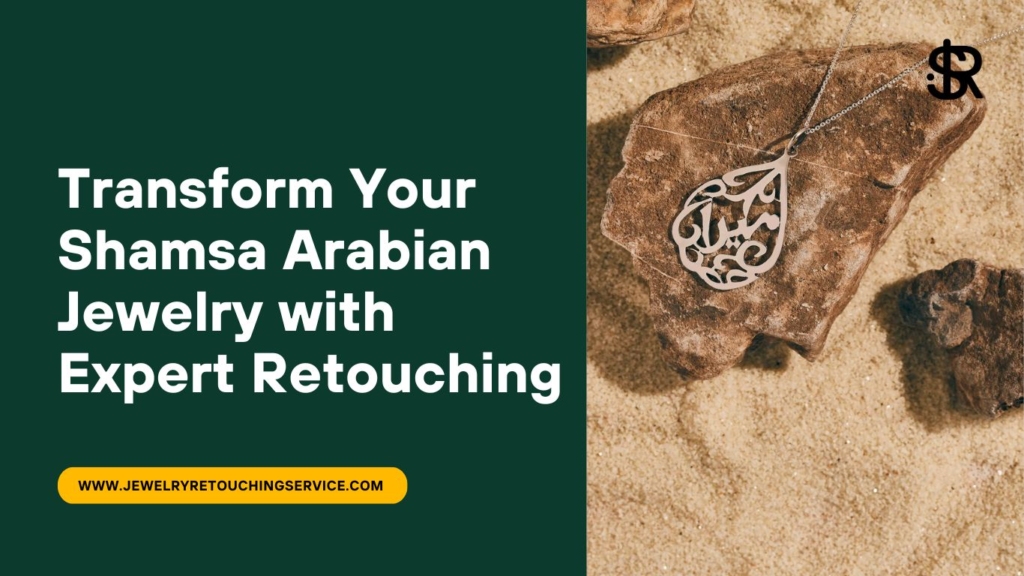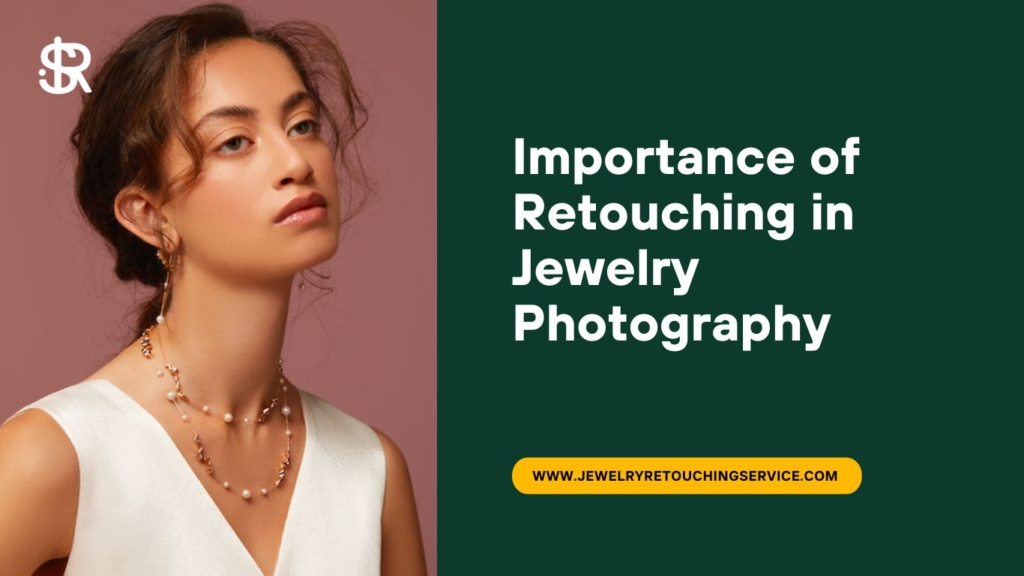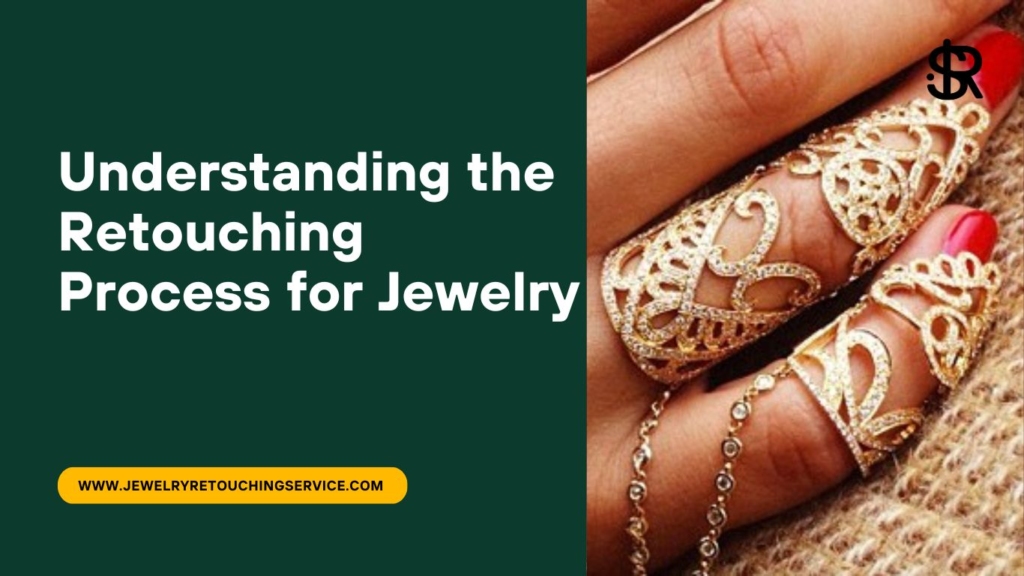This section will provide a brief overview of Shamsa Arabian Jewelry, its history, and its unique features. It will introduce the reader to the brand and what makes it stand out in the world of jewelry.

Importance of Retouching in Jewelry Photography:
In this section, the article will explain why retouching is crucial in the world of jewelry photography. It will touch upon the importance of making the jewelry look as good as possible in photographs, which can help increase sales and attract new customers.
Retouching is an essential part of jewelry photography. It plays a crucial role in enhancing the beauty and appeal of the jewelry, making it look more attractive and desirable to potential buyers.
Jewelry is often made up of tiny details that are difficult to capture accurately in a photograph. Retouching allows photographers to correct any imperfections and highlight the intricate details of the piece.
Furthermore, jewelry is often photographed in different lighting conditions, which can impact the overall appearance of the piece. Through retouching, photographers can adjust the color, brightness, and contrast of the image to ensure that the jewelry looks its best in any lighting situation.
Retouching also allows for consistency in branding. If a jewelry company wants to showcase their products in a particular style or color scheme, retouching can help achieve that consistency across all product images.
In summary, retouching is essential in jewelry photography as it helps highlight the beauty of the piece, correct any imperfections, and achieve consistency in branding. It is a powerful tool that can take a good photograph and transform it into a great one, increasing the chances of attracting potential buyers and making sales.

Understanding the Retouching Process for Jewelry:
This section will provide a detailed explanation of the retouching process for jewelry. It will cover the basics of photo editing and the techniques used to enhance the look of jewelry in photographs.
Retouching is a complex process that involves correcting and enhancing the appearance of a jewelry photograph. The process typically involves the following steps:
Cleaning the Image: The first step in the retouching process is to clean the image of any dust, scratches, or unwanted elements that may have been captured during the photoshoot.
Color Correction: The next step is to adjust the color balance, saturation, and brightness of the image to ensure that the jewelry looks its best.
Detail Enhancement: Detail enhancement involves using various techniques such as sharpening, contrast adjustment, and highlights and shadows adjustment to enhance the intricate details of the jewelry.
Background Removal: In some cases, the jewelry may need to be extracted from its background and placed onto a new background. This is typically done using techniques such as clipping paths or image masking.
Consistency: Consistency is key in jewelry photography. Retouching helps ensure that all product images are consistent in terms of color, lighting, and overall style.
Quality Control: Finally, quality control is essential to ensure that the final image meets the desired standards. This involves carefully examining the image for any imperfections or inconsistencies that may have been missed during the retouching process.
In conclusion, retouching is a vital process in jewelry photography that can significantly enhance the beauty and appeal of the jewelry. The process involves several steps, including image cleaning, color correction, detail enhancement, background removal, consistency, and quality control, all of which are crucial to achieving the desired result.

Techniques Used in Shamsa Arabian Jewelry Retouching:
This section will cover the specific techniques used in retouching Shamsa Arabian Jewelry. It will explore the unique challenges that arise when retouching this type of jewelry and the solutions used to overcome them.
Shamsa Arabian Jewelry Retouching is a specialized technique that requires a deep understanding of the intricacies of jewelry photography. The following are some of the most common techniques used in Shamsa Arabian Jewelry Retouching:
Color Correction: Color correction is an essential technique in Shamsa Arabian Jewelry Retouching. It involves adjusting the color balance, saturation, and brightness of the image to ensure that the jewelry looks its best. In particular, the warm tones commonly used in Arabian jewelry require special attention to ensure that the colors appear rich and vibrant.
Detail Enhancement: Detail enhancement is a crucial technique that involves using various tools such as sharpening, contrast adjustment, and highlights and shadows adjustment to enhance the intricate details of the jewelry. This is especially important for capturing the delicate textures and patterns of Arabian jewelry.
Background Removal: In many cases, the jewelry may need to be extracted from its background and placed onto a new background. This is typically done using techniques such as clipping paths or image masking to ensure a clean and professional look.
Consistency: Consistency is key in Shamsa Arabian Jewelry Retouching. This involves ensuring that all product images are consistent in terms of color, lighting, and overall style. This is particularly important for maintaining a cohesive brand image.
Retouching for Reflections: Reflections can be an essential element of jewelry photography, adding depth and dimension to the image. However, they can also be distracting and take away from the jewelry’s beauty. Shamsa Arabian Jewelry Retouching requires careful attention to balancing the reflection’s impact to ensure the jewelry stands out while still having the necessary visual depth.
Quality Control: Finally, quality control is essential to ensure that the final image meets the desired standards. This involves carefully examining the image for any imperfections or inconsistencies that may have been missed during the retouching process.
In conclusion, Shamsa Arabian Jewelry Retouching requires a deep understanding of the nuances of jewelry photography, along with specialized techniques such as color correction, detail enhancement, background removal, consistency, retouching for reflections, and quality control. These techniques are essential in creating a visually appealing and effective product image that accurately showcases the beauty of the jewelry.
Common Issues Faced in Jewelry Retouching and How to Overcome Them:
In this section, the article will cover the common issues faced in jewelry retouching and the best ways to overcome them. This can include issues such as reflections, dust, and scratches.
Jewelry retouching is a complex process that requires a deep understanding of the intricacies of jewelry photography. However, even with the best techniques, there are common issues that can arise during the retouching process. Here are some of the most common issues faced in jewelry retouching and how to overcome them:
Dust and Scratches: One of the most common issues in jewelry photography is dust and scratches on the jewelry’s surface. These can be removed using the healing brush tool or clone stamp tool in Photoshop. It is essential to zoom in and take care when removing these imperfections, as the details of the jewelry are often small and intricate.
Color Inconsistencies: Color inconsistencies can be challenging to overcome, particularly when dealing with warm-toned jewelry such as Arabian jewelry. It is essential to use the color balance tool in Photoshop to adjust the colors and ensure that the jewelry looks its best. However, it is important to maintain consistency across all images in the product line, so that the entire product range looks cohesive and professional.
Background Distractions: Background distractions can be problematic in jewelry photography, particularly if they detract from the jewelry’s beauty. Removing the background or replacing it with a solid color is one way to overcome this issue. However, this should be done carefully, to ensure that the jewelry is still well-defined against the new background.
Reflections: Reflections can be an essential part of jewelry photography, but they can also be distracting if not handled correctly. One way to overcome this issue is to use the clone stamp tool or healing brush to remove any unwanted reflections. It is essential to be careful when doing this, as reflections can add depth and dimension to the image.
Quality Control: Finally, quality control is crucial in ensuring that the final image meets the desired standards. This involves carefully examining the image for any imperfections or inconsistencies that may have been missed during the retouching process. It is essential to zoom in and take care when checking the image, as the details of the jewelry are often small and intricate.
In conclusion, jewelry retouching is a complex process that requires careful attention to detail. The common issues faced in jewelry retouching, such as dust and scratches, color inconsistencies, background distractions, reflections, and quality control, can be overcome using a combination of specialized techniques and attention to detail. By addressing these issues, it is possible to create visually appealing and effective product images that accurately showcase the beauty of the jewelry.
Best Practices for Retouching Shamsa Arabian Jewelry:
This section will provide tips and best practices for retouching Shamsa Arabian Jewelry. This can include recommendations for lighting, camera settings, and post-processing techniques.
Retouching Shamsa Arabian jewelry requires a combination of specialized techniques and attention to detail to create visually appealing and effective product images. Here are some best practices for retouching Shamsa Arabian jewelry:
Focus on the Details: Shamsa Arabian jewelry is often intricate and detailed, and it is essential to focus on those details during the retouching process. Zoom in and take care when removing imperfections, adjusting colors, or removing background distractions to ensure that the jewelry’s beauty and intricate details are maintained.
Use a Consistent Workflow: Consistency is crucial when retouching a product line of jewelry, such as Shamsa Arabian jewelry. Establish a workflow that includes using consistent settings, tools, and techniques for all images to ensure that the product line looks cohesive and professional.
Pay Attention to Color: Shamsa Arabian jewelry is often warm-toned, and it is important to pay attention to the colors during the retouching process. Use the color balance tool to adjust the colors and ensure that they look natural and vibrant, but also maintain consistency across all images in the product line.
Remove Reflections Carefully: Reflections can be an important part of Shamsa Arabian jewelry photography, but they can also be distracting if not handled correctly. Use the clone stamp tool or healing brush to remove unwanted reflections, but be careful to preserve the depth and dimension of the jewelry in the process.
Ensure Quality Control: Finally, quality control is crucial in ensuring that the final images meet the desired standards. Carefully examine each image for any imperfections or inconsistencies that may have been missed during the retouching process, and make necessary adjustments to ensure that the final images are of the highest quality.
In conclusion, retouching Shamsa Arabian jewelry requires a combination of specialized techniques and attention to detail. By focusing on the details, using a consistent workflow, paying attention to color, removing reflections carefully, and ensuring quality control, it is possible to create visually appealing and effective product images that accurately showcase the beauty of the jewelry.
The Role of Color Correction in Jewelry Retouching:
This section will explore the importance of color correction in jewelry retouching. It will cover the basics of color theory and how to use color correction techniques to enhance the beauty of jewelry in photographs.
Color correction plays a crucial role in jewelry retouching. It is an essential part of the process that involves adjusting the colors of an image to ensure that they look natural, vibrant, and accurate to the product. In jewelry photography, color accuracy is crucial to accurately showcase the beauty and intricate details of the jewelry.
Here are some key ways in which color correction plays a vital role in jewelry retouching:
Adjusting White Balance: Jewelry is often photographed under various lighting conditions, and the white balance can be affected, resulting in a shift in colors. Color correction can help adjust the white balance to ensure that the image’s colors are accurate and natural.
Correcting Tones: The tones of an image can also affect the color accuracy. For instance, images with a warmer tone can result in yellowish hues on the jewelry. Color correction can help adjust the tones to ensure that the jewelry’s colors look natural and accurate.
Adjusting Saturation: Jewelry is often highly reflective, which can cause some colors to appear less saturated in images. Color correction can help adjust the saturation of the colors to ensure that they look vibrant and accurate.
Maintaining Consistency: Maintaining consistency in color across all images is essential when retouching jewelry, especially when working on a product line. Color correction can help ensure that all images in the product line have the same color balance, tones, and saturation, resulting in a cohesive and professional product line.
In conclusion, color correction plays a crucial role in jewelry retouching. It helps adjust the colors to ensure that they look natural, vibrant, and accurate, making the jewelry appear in its best form. By adjusting white balance, correcting tones, adjusting saturation, and maintaining consistency, color correction helps create visually appealing and effective product images that accurately showcase the beauty and intricacy of the jewelry.
Importance of Consistency in Shamsa Arabian Jewelry Retouching:
This section will discuss the importance of maintaining consistency in Shamsa Arabian Jewelry retouching. It will explain how consistent editing can help maintain the brand’s identity and make the jewelry recognizable to customers.
Consistency is crucial in Shamsa Arabian jewelry retouching. When working on a product line, ensuring that all images look consistent and professional is vital in building a brand image and customer trust. Here are some key reasons why consistency is essential in Shamsa Arabian jewelry retouching:
Establishing Brand Identity: Consistency in image editing is key to establishing a brand identity for Shamsa Arabian jewelry. By ensuring that all images have a consistent look, feel, and style, the brand becomes easily recognizable, and customers are more likely to remember and trust the brand.
Maintaining Customer Trust: Customers expect consistency when they purchase products from a brand. By ensuring that all images look consistent and professional, customers are more likely to trust the brand and purchase the product. In contrast, inconsistent images can create confusion and uncertainty, leading to a lack of trust in the brand.
Creating Cohesive Product Line: Shamsa Arabian jewelry is often sold as a product line, and consistency is crucial in ensuring that all images within the product line look cohesive and professional. When all images have a consistent style and editing, it creates a seamless flow, making the product line appear well-curated and visually appealing.
Streamlining the Workflow: Establishing a consistent workflow in Shamsa Arabian jewelry retouching can help streamline the editing process, saving time and increasing productivity. By using consistent settings, tools, and techniques for all images, the editing process becomes more efficient, allowing for more images to be retouched in a shorter period.
In conclusion, consistency is essential in Shamsa Arabian jewelry retouching. It helps establish a brand identity, maintain customer trust, create a cohesive product line, and streamline the workflow. By ensuring that all images have a consistent look, feel, and style, Shamsa Arabian jewelry can be effectively marketed and sold, creating a positive customer experience and building brand loyalty.
Tools and Software Used in Jewelry Retouching for Shamsa Arabian Jewelry:
This section will provide an overview of the tools and software used in jewelry retouching for Shamsa Arabian Jewelry. This can include recommendations for software programs and hardware, as well as tips for using them effectively.
Jewelry retouching for Shamsa Arabian Jewelry requires the use of specialized tools and software to achieve the best results. Here are some of the most commonly used tools and software in jewelry retouching for Shamsa Arabian Jewelry:
Adobe Photoshop: Adobe Photoshop is the industry-standard software for jewelry retouching. It provides advanced editing tools, such as layers, masks, and adjustment layers, which are essential for jewelry retouching.
Capture One: Capture One is a powerful photo editing software that offers advanced color grading and color correction tools. It is often used by professional photographers for jewelry retouching.
Wacom Tablets: Wacom tablets are an essential tool for jewelry retouching, as they provide more precision and control when working with images. They are particularly useful when retouching intricate details in jewelry.
High-Resolution Monitors: High-resolution monitors are essential for jewelry retouching, as they provide accurate color representation and help identify any imperfections in the images.
Retouching Plugins: Various retouching plugins, such as Imagenomic Portraiture and Alien Skin Exposure, can be used to automate certain aspects of jewelry retouching, such as skin smoothing and color correction.
Digital Calipers: Digital calipers are used to measure the dimensions of jewelry accurately, ensuring that they are retouched to their actual size and shape.
In conclusion, jewelry retouching for Shamsa Arabian Jewelry requires the use of specialized tools and software to achieve the best results. Adobe Photoshop, Capture One, Wacom Tablets, High-Resolution Monitors, Retouching Plugins, and Digital Calipers are some of the most commonly used tools and software in jewelry retouching. By using these tools, retouchers can ensure that the jewelry images are retouched to their best possible quality, resulting in visually appealing and effective product images.
Conclusion:
Enhancing the Beauty of Shamsa Arabian Jewelry through Retouching: This section will summarize the key points of the article and emphasize the importance of retouching in enhancing the beauty of Shamsa Arabian Jewelry. It will provide a final takeaway for readers on how to make their jewelry photographs look their best.


